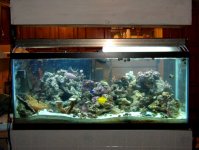I had kept a 55 gallon and a 29 gallon side by side for the past year or so pretty much right on the floor, everything half rigged together, and strapped in on a budget.
FINALLY IT HAS COME!!! I built a new counter ready to hold a ton + of weight and a new setup from Inland Reef Aquaria.
at least 50% of this water and 75% of the sand and 90% of the rock was cycled from my old tanks when I set up so this tank was cycled rapidly.
It is a 75G glass aquarium with internal overflow and holes pre-drilled in the bottom. I got the plumbing kit and $15 of PVC and valves from Ace and this setup was ready. Under the counter is a standard 20G tank that I put a divider in the middle. half water is trickled in for a lighted refugium. The other side is for my skimmer (If Aqua direct ever gets it to me), heater, pumpand where my RO/DI will do manuakl top-offs when needed.
The hood has 2 175 MH bulbs. I am keeping soft corals only with fish so I feel this should be sufficient light.
I made almost all of the Live Rock myself. It has taken over a year to figure out how to make tank safe rock, and it takes nearly half that to wait for it to cure before plopping it into the tank. The result though is nice. I plan to make WAY more and place and sell small bits after it is "live".
FINALLY IT HAS COME!!! I built a new counter ready to hold a ton + of weight and a new setup from Inland Reef Aquaria.
at least 50% of this water and 75% of the sand and 90% of the rock was cycled from my old tanks when I set up so this tank was cycled rapidly.
It is a 75G glass aquarium with internal overflow and holes pre-drilled in the bottom. I got the plumbing kit and $15 of PVC and valves from Ace and this setup was ready. Under the counter is a standard 20G tank that I put a divider in the middle. half water is trickled in for a lighted refugium. The other side is for my skimmer (If Aqua direct ever gets it to me), heater, pumpand where my RO/DI will do manuakl top-offs when needed.
The hood has 2 175 MH bulbs. I am keeping soft corals only with fish so I feel this should be sufficient light.
I made almost all of the Live Rock myself. It has taken over a year to figure out how to make tank safe rock, and it takes nearly half that to wait for it to cure before plopping it into the tank. The result though is nice. I plan to make WAY more and place and sell small bits after it is "live".






